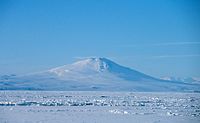
Photo from wikipedia
Abstract Deception Island is one of the most active volcanoes in Antarctica, with more than 20 monogenetic eruptions during the Holocene. The latest episodes of 1967, 1969, and 1970 have… Click to show full abstract
Abstract Deception Island is one of the most active volcanoes in Antarctica, with more than 20 monogenetic eruptions during the Holocene. The latest episodes of 1967, 1969, and 1970 have shown that volcanic activity on Deception Island can become a concern for tourists, scientists, and military personnel working on or near the island. The objective of this work is to identify eruptive processes and the geomorphic evolution of post-caldera monogenetic volcanic edifices at Deception Island by morphometric analyses, supported by field observations. Morphometric analysis has been used since the 1970s to analyse scoria cones, but it has rarely been applied to other monogenetic volcanoes, such as tuff cones and tuff rings. Tuff cones and tuff rings represent the most common landforms during Deception Island's recent geological past, with over 70 scattered eruptive vents inside and along the caldera rim. These volcanic landforms have been studied based on field observations and later, Digital Elevation Model analyses. Their geometry ranges from 10 to 100 m in height, and diameters vary between 300 and 2500 m. The morphometric data suggest that tuff cones have a more circular crater than tuff rings, with a significant separation between the two landforms using the height (Hco) and basal width (Wco) parameters. Tuff cones have Hco/Wco ratios with values between 0.04 and 0.16 and outer slopes between 7° and 34°. Tuff rings have lower Hco/Wco ratios that are between 0.01 and 0.04 and lower outer slopes between 3° and 21°. This study shows that basic shape parameters in combination with slope angle analysis can be used to discriminate among different types of monogenetic volcanoes. The initial eruptive-related morphometric diversity, however prevents correlation of eruption ages with morphometric parameters, or constructing a relative chronology of the monogenetic eruptions. This work provides a better comprehension of the potential evolution of a future eruption and a broader understanding of volcanic hazards on Deception Island.
Journal Title: Journal of Volcanology and Geothermal Research
Year Published: 2020
Link to full text (if available)
Share on Social Media: Sign Up to like & get
recommendations!